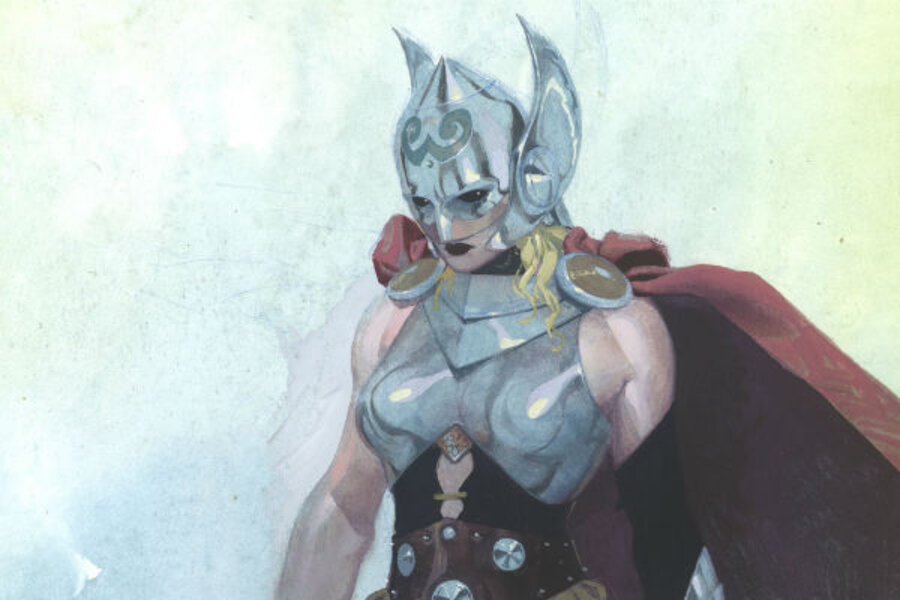Female Thor and Black Captain America: Strong characters beyond the suit
Loading...
Captain America is Black, Thor is a woman with Titanic attributes, Ms. Marvel, whose latest issue came out yesterday, is a modestly dressed Muslim teen hero. Parents face a host of new role models and issues to navigate with kids as Marvel Comics continues to expand its universe of superheroes.
“Fans are used to characters changing and switching around, turning into women – it’s traditionally pretty common,” said Matt Desiderio, manager at Forbidden Planet comics in New York City in a phone interview. “What’s great about this is that finally there’s enough money and interest in comics that Marvel can think about ways to change and open up the characters to a broader audience.”
Reaction on Twitter for the two characters was mixed, with some critiquing Marvel on their choice, others celebrating what seems like a progressive step, and more already talkng about who would play the characters in their film adaptations.
I think Mr. Desiderio has the right track on this when he says, “Think about it. Captain America is black. Thor’s a woman and Ms. Marvel is a Muslim. It’s not just white people. It’s good. It’s a good thing.”
I agree. It’s great that Marvel introduced a black Captain America Wednesday on the Cobert Report, replacing Steve Rogers with his long-time ally Sam Wilson, also known as the Falcon.
The fact that this happened after the release of the new “Avengers: Age of Ultron" film, in which Falcon plays a role only serves to bolster Desedario’s conclusion that money and popularity are driving forces behind universal shifts in the world of comics.
The Captain has always been the blond, bullied, 98-pound weakling with the perfect moral compass who volunteers to be part of a military experiment to make super humans to fight Hitler.
Rogers becomes the buff hero who protects and defends, always doing the right thing.
As the mom of four sons with 20 years in the parenting game, I think Desedario also makes a great point about kids relating to the characters that reflect their physical and social attributes.
I have observed that kids tend to choose their heroes and Halloween costumes according to both physical and social characteristics exhibited by that particular hero.
My four sons, ranging in age from 20 to 10, range in physical looks from blond and buff to brunette and lean, and in personalities from outgoing leaders to thoughtful brooding heroes. At any given time, my household is rooting for Captain America, Thor, Iron Man, or Batman as the hero of the moment.
My youngest son Quin, 10, wants to be a different character every day of the week, depending on his mood.
“Well, Thor’s out now ‘cause now he’s a girl,” Quin said. “I can’t work with that! They just ruined one of the most OP [Over-powered] superheroes for me!”
Quin’s reaction tells me that for parents who have kids who deeply relate to the current character on a gender level, things just got complicated.
No amount of discussion is changing my son’s mind and he has piled the Thor costume armor in the box with things we give to charity.
I wonder if boys who refuse to give up their Thor armor might need some emotional reinforcement in the event that they are mocked by those who now see the character as a female.
It’s also likely that this Halloween some little girl Thors will be told by well-meaning people, “I love your Xena Warrior Princess outfit!”
I am concerned that the dance Marvel is doing – by first introducing a modest Ms. Marvel, Kamala Kahn in 2013, and then boomeranging back with an armored, buxom version of a female Thor – is a bit like the Cha-cha. It seems like almost a small step forward and a rock backwards to make several steps in place.
I say this because the male Thor possesses muscles a person could realistically build, while the female version, in my opinion, is a powerful woman who is bound in a way to a form that even Barbie can’t hope to achieve without making a new mold.
Therefore, while some racial and gender stereotypes are in for an Avengers-style beat-down thanks to these changes in the Marvel universe, others might be reinforced by the new Thor’s body type and costume.
It’s great that Marvel didn’t diminish her with a name like “Thorina” or “Miss Thor.” But perhaps it might consider building her like a gymnast, body builder, or triathlete, without the Madonna-like Double D cones in the breastplate.
While we could spend a lot of time talking about how these characters look on the surface, it's most important to remember that if Marvel maintains their core values, chances are these characters will remain fan favorites.
Overall, I do believe this is a win because more kids will find comics accessible and appealing when they see themselves reflected in some way in a character on a comic book cover. That’s what is super about the new Marvel heroes.








